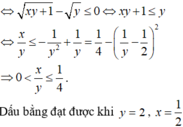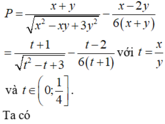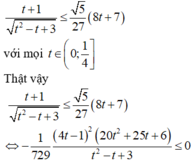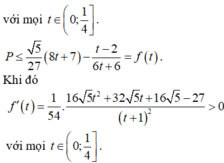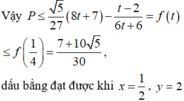
Hãy nhập câu hỏi của bạn vào đây, nếu là tài khoản VIP, bạn sẽ được ưu tiên trả lời.


y = (2 + cosx) / (sinx + cosx - 2) (1)
Ta có: sinx + cosx - 2 = √2.sin(x + π/4) - 2 ≤ √2 - 2 < 0
(1) ⇔ y.(sinx + cosx - 2) = 2 + cosx
⇔ y.sinx + (y - 1).cosx = 2y + 2
Phương trình trên có nghiệm ⇔ y² + (y - 1)² ≥ (2y + 2)²
⇔ y² + y² - 2y + 1 ≥ 4y² + 8y + 4
⇔ 2y² + 10y + 3 ≤ 0
⇔ (-5 - √19)/2 ≤ y ≤ (-5 + √19)/2
Vậy Miny = (-5 - √19)/2
Maxy = (-5 + √19)/2

Lời giải:
Tìm đạo hàm theo biến $y$, bạn chỉ cần coi $x$ là một tham số rồi sử dụng công thức như bình thường thôi.
\(f(y)=y.e^{xy}.\sin y\)
\(\Rightarrow f'(y)=(y.e^{xy})'\sin y+y.e^{xy}(\sin y)'\)
\(=[y'.e^{xy}+y(e^{xy})']\sin y+y.e^{xy}.\cos y\)
\(=(e^{xy}+yxe^{xy})\sin y+y.e^{xy}\cos y\)
----------------------------------
Tính đạo hàm cấp 2.
Theo biến $x$
\(f(x)=e^{xy}\sin y\)
\(\Rightarrow f'(x)=\sin y(e^{xy})'=\sin y.ye^{xy}\)
\(\Rightarrow f''(x)=(y\sin y.e^{xy})'=y\sin y(e^{xy})'=y^2\sin y.e^{xy}\)
Theo biến $y$
\(f(y)=e^{xy}.\sin y\)
\(\Rightarrow f'(y)=(e^{xy})'\sin y+(\sin y)'e^{xy}\)
\(=x.e^{xy}\sin y+\cos y.e^{xy}\)
\(\Rightarrow f''(y)=(xe^{xy}.\sin y+\cos y.e^{xy})'\)
\(=(x.e^{xy}\sin y)'+(\cos y.e^{xy})'\)
\(=(x.e^{xy})'\sin y+(\sin y)'.xe^{xy}+(\cos y)'e^{xy}+\cos y(e^{xy})'\)
\(=x^2e^{xy}.\sin y+\cos y.x.e^{xy}-\sin y.e^{xy}+x\cos y.e^{xy}\)

Không mất tính tổng quát, giả sử \(x=mid\left\{x;y;z\right\}\)
\(\Rightarrow\left(x-y\right)\left(x-z\right)\le0\)
\(\Rightarrow x^2+yz\le xy+xz\)
\(\Rightarrow zx^2+yz^2\le xyz+xz^2\)
\(\Rightarrow P\le x^3+y^3+z^3+8\left(xy^2+xz^2+xyz\right)\)
\(\Rightarrow P\le x^3+y^3+z^3+3yz\left(y+z\right)+8\left(xy^2+xz^2+2xyz\right)\)
\(\Rightarrow P\le x^3+\left(y+z\right)^3+8x\left(y+z\right)^2\)
\(\Rightarrow P\le x^3+\left(4-x\right)^3+8x\left(4-x\right)^2\)
\(\Rightarrow P\le8x^3-52x^2+80x+64\)
Tới đây, đơn giản nhất là khảo sát hàm \(f\left(x\right)=8x^3-52x^2+80x+64\) trên \(\left[0;4\right]\)
(Nếu ko khảo sát hàm, ta có thể tách như sau, tất nhiên là dựa trên điểm rơi có được từ việc khảo sát hàm):
\(\Rightarrow P\le\left(8x^3-52x^2+80x-36\right)+100\)
\(\Rightarrow P\le4\left(x-1\right)^2\left(2x-9\right)+100\)
Do \(0\le x\le4\Rightarrow2x-9< 0\Rightarrow P\le100\)
Dấu "=" xảy ra khi \(\left(x;y;z\right)=\left(1;3;0\right)\) và 1 vài bộ hoán vị của chúng

ta có : \(\left(x+2\sqrt{y}\right)^5=\sum\limits^5_{k=0}.C^k_5.x^k.\left(2\sqrt{y}\right)^{5-k}=C^0_5.\left(2\sqrt{y}\right)^5+C^1_5.x.\left(2\sqrt{y}\right)^4+...+C^4_5.x^4.\left(2.\sqrt{y}\right)+C^5_5.x^{5y}\)
=> hệ số của \(x^3.y\) trong khai triển tương ứng với k = 3
Vậy hệ số tương ứng là: \(C^3_5..2^2=240\)

Ta có : \(y=\frac{1}{1+x+\ln x}\Rightarrow y'=\frac{-\left(1+\frac{1}{x}\right)}{\left(1+x+\ln x\right)^2}=\frac{-\left(1+x\right)}{x\left(1+x+\ln x\right)^2}\)
\(\Rightarrow\begin{cases}xy'=\frac{-\left(1+x\right)}{\left(1+x+\ln x\right)^2}\\y\left(y\ln x-1\right)=\frac{1}{1+x+\ln x}\left(\frac{\ln}{1+x+\ln x}-1\right)=\frac{-\left(1+x\right)}{\left(1+x+\ln x\right)^2}\end{cases}\)
\(\Rightarrow xy'=y\left(y\ln x-1\right)\Rightarrow\) Điều phải chứng minh

